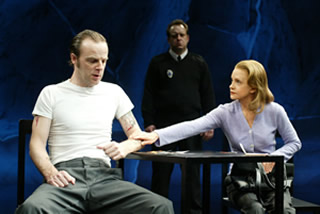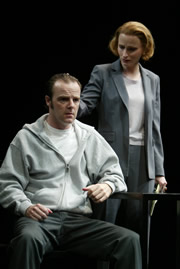
Dead Girl's Dance
By Caridad Svich
Frozen
By Bryony Lavery
Circle in the Square
50th St., W of Broadway
Box office: (212) 239-6200
Frozen is a three-handed portrait
of a pedophile/murderer (played by Brian F. O'Bryne), a criminal
psychologist (played by Laila Robins), and the mother who has
lost her child at the hands of the pedophile (played by Swoosie
Kurtz). It is a clear-eyed, restrained, and intelligent play about
how stricken individuals contain their grief--and moreover contain
their emotions generally for fear of losing themselves to rage,
vengeance and pain. Twisting the knife, as it were, with delicacy
and nuance, Lavery builds her play on a contrapuntal structure
of alternating monologues by each of the characters, bracketed
by tense duets between the murderer and psychologist, and the
psychologist and the grieving mother. The play culminates in a
strange, eerie meeting between the murderer and his victim's mother.
Throughout all the interlocking solos and duets is felt the presence
of the victim herself: a ten-year-old girl named Rhona who has
disappeared on her way to her grandmother's house (not unlike
Little Red Riding Hood), never to return. Rhona is the play's
driving force even though she is absent from the stage. Her death
serves as the catalyst for the three characters' emotional awakenings.
Throughout the course of the play the image which continues to
haunt even the most mundane of conversations is that of this innocent
girl who has been violated and killed by a seemingly ordinary
man.
Much has been made of the subject of pedophilia
and its representation on stage, film and television in the last
several years. Todd Solondz's Happiness and Clint Eastwood's
Mystic River are just two examples of eminent films centered
on pedophiles as anchor points for their narratives. Neil LaBute's
Your Friends and Neighbors used the pedophiliac impulse
of one of its lead characters as a turning point in its story
of suburban loneliness and misanthropy. Week after week on television,
docudramas and fictional shows in the police, law and crime genres
("Law and Order," "CSI," etc.) feature murder and abuse of young
children or adolescents at the hands of pedophiles. The sensationalistic
focus on aberrant behavior in these mainstream dramas has an oddly
prurient quality, despite its moralistic overtones. TV coverage
of the unresolved Jon Benet Ramsey murder, for example, was notable
not for the details of the child beauty queen abducted and killed
in the night, but rather for the entertainment context, the near
giddiness with which reporters both reviled and leered at the
child's beauty-queen photos and video clips. The "Lolita syndrome,"
branded so eloquently and devastatingly by Vladimir Nabokov in
his classic novel, and reinterpreted by Stanley Kubrick and Adrian
Lyne in their film versions of the story, is unhealthily alive
in the media's alternately salacious and puritanical coverage
of young people (girls in particular) meeting their deaths in
acts of abuse and violence.
Dead girls seem to animate our psyches
in ways that dead and victimized boys do not. Iphigenia, Antigone,
and Cassandra haunt our collective Western dramatic imaginations
much more than, say, Medea's two boys. Deborah Warner's staging
of Medea in the UK and US devoted impactful stage time
to the murder of the children as Fiona Shaw, playing Medea, dragged
their limp bodies across the stage, staining the walls of the
palace with their fresh blood. But even the artful, and empathetic
(to the victim) demonstration of violence and its effects in such
a renowned story failed to swerve our attention or compassion
away from the character of Medea. Susan Smith's murder of her
sons, while horrific and scandalous, was almost overridden in
media coverage by Smith herself. Her sons remained somehow nameless
in the public mind. The 1993 death of the three-year-old English
boy Jamie Bulger made the front pages of world newspapers and
internet news services, I propose, not because of the killing
itself but rather because Bulger was murdered by two ten-year-old
boys mere yards away from a shopping center. The story there was
about boys killing another boy. Yet even that story failed to
hold the public imagination for long. It did not have the legs,
for instance, of Princess Diana's untimely death, one of the most
potent (and profitable) dead girl fantasies in recent memory.
We live in a world where what is recorded
by a video camera (security, military, or otherwise) miles away,
a continent away, co-exists with our immediate physical surroundings.
In a culture of watching and being watched, how an audience views
actions on film and stage is altered. As a culture, we have become
increasingly conditioned to view images of violence and abuse
with disaffection and pleasure. In Frozen, Lavery is
savvy enough to save the descriptions of violence in her story
for when they will register most profoundly with an audience.
The writing is pointillistic in design. Details of Rhona's disappearance
and of Ralph's obsessive psychotic behaviour emerge slowly, at
times off-handedly. Lavery focuses our attention on what makes
up a life instead of what destroys it.
Frozen has the boldness, and the
modesty, to scale down its characters to a recognizably human
level. Ralph is a natural monster, not a supernatural one: he
is quiet, efficient and nondescript despite being disturbed and
pathologically disassociated from his feelings. Agnetha, the criminal
psychologist, is ambitious and forthright to a fault. In seeking
scientific greater good, she has nearly barred herself from connection
with other people. While her character is part of a long line
of female figures in contemporary drama that are both burdened
and chastised for their professional ambition, Lavery is deft
in her portraiture. She doesn't take the all-too-easy and familiar
road of making Agnetha an aggressive careerist detached from her
feelings. Agnetha possesses wit, intelligence and passion, if
perhaps a slight disregard for the effect her words or actions
may have on others. Nancy is the immediate audience connective,
and knowing this, Lavery draws her coolly at first. Nancy is isolated
and disconnected. She is placid in her grief, and her chattery
nature is a mask for the deep well of pain she is in from the
loss of her child: her other self.
Lavery does not flinch from looking at
the nature of aberrant behavior, but the strength of her work
is in her ability to go beyond a case-study approach to aberrance.
Lavery broaches the difficult subject of forgiveness, by her characters
and her audience. As she put it in a recent interview with me:
I think Frozen presents both
forgiveness and revenge as options...and I think it is fairly
clear that the two roads have difficulties...but I think if
we can encourage our audiences to rehearse the act of mercy...it
feels good in our fibre and bones and guts.
 Witnessing
Frozen we are asked to rid ourselves of the fantasy of
the beautiful dead girl, of the sacrificial innocent of myths
and stories, and contemplate with exactness and lack of morbidity
the consequence of death in our lives. Lavery does not ask the
audience to exonerate the murderer but she does ask that we come
to a more comprehensive understanding of the workings of the human
brain as we examine the events of the narrative. Using elements
of the detective and horror genres (both of which deal with human
mortality), Lavery sets up an atmosphere of quiet dread rather
than suspense. Her craft is to steer the audience as much as possible
away from pre-conditioned reflexes toward stories of interrogation
and investigation seen many times before. The murderer, after
all, is a solitary drifter, cut from the cloth of characters instantly
recognizable from crime stories: the outsider, outlaw, the lonely,
volatile male figure roaming the primal landscape at one with
its random, casual violence. Under Doug Hughes's astute direction,
however, O'Byrne is encouraged (as Ralph) to underplay the mad-marauder
aspects of the role and concentrate instead on his ordinariness
and fierceness. This works to the play's advantage. Indeed, the
entire cast is called upon to deliver a particular kind of poetically
exact performance. Lavery's play is not realistic in the Victorian
sense of so much contemporary drama but rather poetic, with a
heightened and remarkably precise speech and manner. The language
does not ape everyday speech but exacts and essentializes it.
Witnessing
Frozen we are asked to rid ourselves of the fantasy of
the beautiful dead girl, of the sacrificial innocent of myths
and stories, and contemplate with exactness and lack of morbidity
the consequence of death in our lives. Lavery does not ask the
audience to exonerate the murderer but she does ask that we come
to a more comprehensive understanding of the workings of the human
brain as we examine the events of the narrative. Using elements
of the detective and horror genres (both of which deal with human
mortality), Lavery sets up an atmosphere of quiet dread rather
than suspense. Her craft is to steer the audience as much as possible
away from pre-conditioned reflexes toward stories of interrogation
and investigation seen many times before. The murderer, after
all, is a solitary drifter, cut from the cloth of characters instantly
recognizable from crime stories: the outsider, outlaw, the lonely,
volatile male figure roaming the primal landscape at one with
its random, casual violence. Under Doug Hughes's astute direction,
however, O'Byrne is encouraged (as Ralph) to underplay the mad-marauder
aspects of the role and concentrate instead on his ordinariness
and fierceness. This works to the play's advantage. Indeed, the
entire cast is called upon to deliver a particular kind of poetically
exact performance. Lavery's play is not realistic in the Victorian
sense of so much contemporary drama but rather poetic, with a
heightened and remarkably precise speech and manner. The language
does not ape everyday speech but exacts and essentializes it.
Ralph is remorseless. Agnetha is curiously
drawn to him while she examines him. Nancy is enraged, desperate,
determined and strangely calm once the gears of the story are
set in motion (from Rhona's disappearance, to waiting for her
return, to receiving word after twenty years that in fact Rhona
will not return, since her remains are found in Ralph's shed).
The play is by turns blunt and discreet with its portrayal of
grief. When Nancy mimes holding Rhona's skull before her remains
are finally laid properly to rest, Nancy remarks to the mortician,
"It's beautiful." It is an unexpected moment in the play, for
it asks us all, as collective witnesses to this story, to hold
the dead girl in our hands, and consider what it means to do so.
Frozen refuses the gamesmanship
and showmanship of contemporary life. It is full of silence and
sorrow, even in its moments of amusement at the peculiarities
and eccentricities of the human condition. It is a play of steady
power that forces us to question the value we place on life itself.
It posits, in effect, that if we rehearse our acts of mercy enough,
mercifulness may not seem extraordinary but natural instead.
